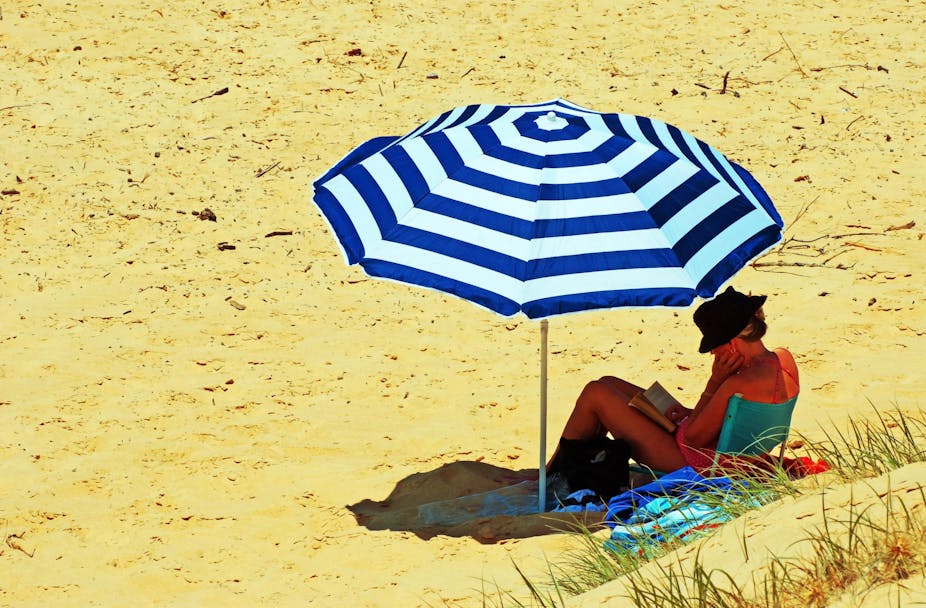Summertime and reading always went together in my family. Whether we were sunbathing on hot silky beach sand or cooling off in the back yard under a shady plum tree, our books came too. In those pre-digital days, the best Christmas presents were books – the paper and cardboard kind, with a spine you could crack. Ideally, something that’d last the distance so we wouldn’t run out of good reading before the end of the holidays.
The latest novels by David Malouf, Peter Carey, Roger MacDonald or Elizabeth Jolley, short stories by Olga Masters, Tom Hungerford or Frank Moorhouse; writing that evoked the heat of the Australian landscape, the troubling complexities of our history, the nuances of our urban culture.

These days I always have a few books in my pocket … well, on my phone.
Reading in Australia is a national pastime and we are blessed with an enormous range of lively, engaging, well written and intellectually stimulating sources, from traditional and electronic book publishing to outstanding literary journals such as Meanjin, Overland, Island, Australian Book Review and Verity La, to online current affairs publications such as The Conversation and The Monthly, which are embedded with strong literary and arts content.
Many Australian writers are going further, producing non-fiction and experimental creative writing through social media platforms.
But it’s is not just the new and contemporary that attracts Australian readers. A sense of our literary heritage remains strong, shown by the celebration that surrounded the publication of Patrick White’s unfinished novel The Hanging Garden by Random House in 2012. White is one of several Australian writers of international renown whose works have influenced more recent generations of Australian writers.

When asked about his favourite books by the Australian Book Review last year, Brisbane-based author Matthew Condon named H. H. Richardson’s trilogy Fortunes of Richard Mahony and Patrick White’s Twyborn Affair.
Arguably, in their treatment of very different times and contexts, both works of fiction deal with how our colonial past has shaped relationships between place, landscape and identity.
Some of the latest Australian literary releases deal with these themes, pointing out that our culture hasn’t yet grasped the necessities of dwelling in this fragile continent.
Dislocation
Several notable books available for this summer’s reading explore this alienation. John Kinsella’s new short story collection Tide (Transit Lounge, 2013) – harsh, salt-riven and utterly convincing – and Tim Winton’s Eyrie (Penguin, 2013), whose jaded principle character stares down from a high-rise apartment at a society seemingly bent on acquisition and superfluity, are both concerned with disconnection from place and community.

For Winton’s characters there is always a prospect of redemption. Other authors offer a sharper and more pressing vision. Alexis Wright in The Swan Book (Giramando, 2013) is vitally engaged in expressing the importance of narrative meanings of place.
Wright’s dramatisation of the future of climate change reminds us that the cultural and social impact of land appropriation and environmental destruction are real and profound.
Although very different, Christos Tsiolkas’s Barracuda (Allen & Unwin, 2013) also provokes its readers to think and debate about clichés and contradictions of place and nationhood through its critique of class and sport in Australia. It’s a novel that shows the damage of privilege and excess, but also reveals a glimpse of repair.
Lost children
Allied to the sense of dislocation that flows through the veins of our literature, is the abiding motif of the disappearing child, explored, for example in Carmel Bird’s 1991 book Bluebird Café (New Directions, 1991) and David Malouf’s novels, where it appears as a figure of shadowy transition between worlds and times.

The lost child remains a powerful symbol in Australian fiction and non-fiction narrative. The family impact of such loss is powerfully reflected in Kristina Olssen’s poetic memoir Boy, Lost (UQP, 2013), which tells the story of a child seized from the arms of his mother at her moment of flight.
Due for release by Text Publishing this month, Suzanne McCourt’s Lost Child also deals with the family reaction to a missing child, while Stephen Orr’s forthcoming literary crime novel One Boy Missing (Text, 2014) deals with the intractable mystery that surrounds the reappearance of a missing boy.
Dialogue and diversity
Australians have taken to e-publishing with many now books available in digital as well as print formats. The book industry has been transformed by the online communication age, opening a dialogue between writers and readers, as we engage with each other through social media.
Australian writers are responding actively, experimenting with how digital media can be adapted for new forms of writing and publishing. At the same time, the health of Australian writing can be measured by the growing number of literary competitions which attract more writers each year; awards for more familiar genres of writing fiction, poetry and non-fiction such as the Ulrich and Stella prizes. Rather than overtaking traditional forms, digital writing adds variety and diversity to literature in Australia.
As I turn on my phone in the air-conditioned train to read a chapter, I’m not alone. There are dozens of devices like mine in operation around me. I have to admit, though, that on a hot sandy beach, or in a long relaxing bath, there is no substitute for a good paperback.

